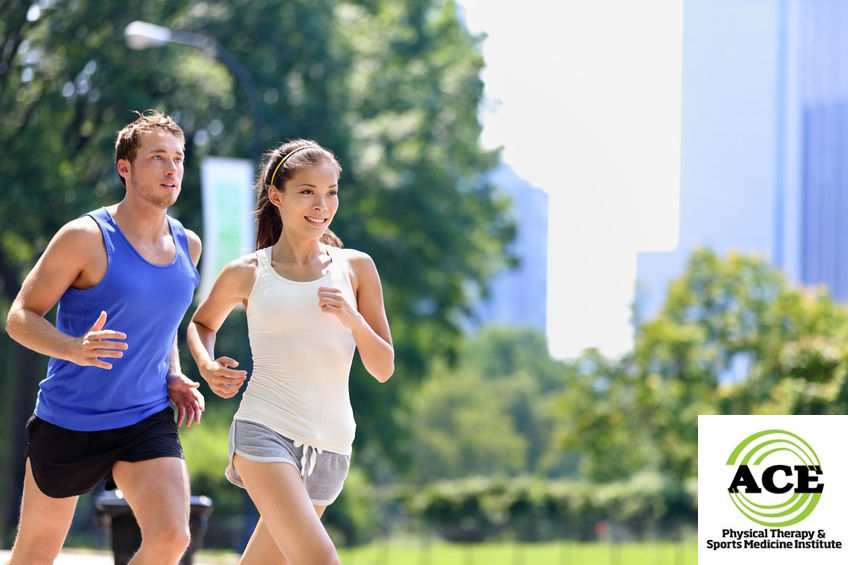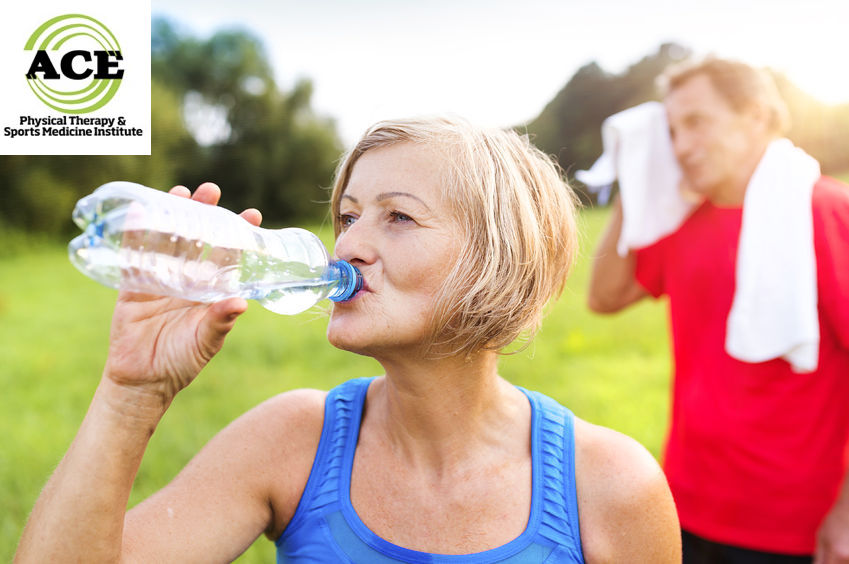RUNNING IN THE HEAT
Running in the Heat
by ACE Physical Therapy and Sports Medicine Institute
Tid Bits of Info.
- Dew point temperatures of 65 degrees F will feel uncomfortable and greater than 75 degrees F can be dangerous.
- Heat exhaustion will include a body temperature up to 104 degrees F and greater than that leads to heat stroke.
- If you wait to hydrate when you feel thirsty it is too late. Hydrate pre, during and post competition.
- As the temperature rises, your running speed and pace will decrease.
- Sweating helps to cool our systems but can lead to dehydration and “thicker” blood.
Hot, humid weather can make outdoor exercise brutally exhausting. Without proper preparation, running in the heat can actually be hazardous. Some athletes have even suffered heat related illnesses like heat exhaustion and heat stroke. If you plan on running in the heat, you should prepare your body and familiarize yourself with signs of over-heating.
Maintaining a safe body temperature is essential. Normal body temperature is approximately 98.6 F, and our bodies will respond to hot weather environments through normal physiological processes to maintain that temperature. Sweating is a key part of remaining cool, but this also means that dehydration is a real threat. When dehydration occurs, normal bodily functions can be jeopardized, skill levels begin to falter, and the body faces the threat of heat related illness.
Hydration and Hot Weather Exercise
Our bodies average 50% to 65% water, and approximately 10% of that water is in the blood. If someone is active in a hot and humid environment, it can be depleted. Sweating cools the body during hot weather conditions. The blood flow is shifted to transport more blood to the surface or skin and with it comes the heat within the body. As we sweat, the water in the sweat evaporates from the skin.
In dry, hot conditions the amount of water or sweat needed to cool the system is less than in hot, humid conditions because the amount of water that evaporates is different. In hot, humid weather there is minimal evaporation due to the amount of moisture in the air. Consequently the body sweats more profusely in an attempt to reduce the temperature. Replenishing the lost water due to sweat is essential to prevent dehydration and possible injury or death.
Preparing for Hot Weather Exercise
Here are some common sense tips to prevent dehydration and heat-related illnesses:
1. Stay hydrated: If you wait to “feel thirsty” you are already beginning to get dehydrated. Drink fluids (preferably cool/cold water) well before you begin to be active in the hot weather. Avoid drinks that at loaded with sugar. Some sports drinks have a lot of sugar in them and this prevents easy up-take in the gut. Attempt to drink approximately 4-6 oz of cool water while you exercise every 10-15 min. Post activity is a critical time to re-hydrate. You should continue to drink until your urine is a very pale yellow color.
2. Wear proper clothing: Choose loose, light colored clothes. You may also consider one of the many new fabrics made to help “wick” away the sweat from the skin in an attempt to help the cooling process. There are also some fabrics that are designed to be a sunscreen. All of these fabrics are great, but if the sweat does not evaporate, your body will remain over-heated.
3. Choose exercise times wisely: Early morning and evening hours are the coolest and best time to run.
4. Get acclimated: If you are continuously active in hot weather conditions, your body will adjust, acclimating to the heat. Begin the process by going shorter time periods and distances at a slower pace. Slowly increase both intensity and time over a course of several days. It is crucial that you re-hydrate after each session and do not perform another workout until the re-hydration process is complete. Remember: the lack of complete re-hydration will make you more susceptible to de-hydration every time you are active in the hot weather environment.
5. Cool down: When finished working or exercising in the hot weather be sure to spend the re-hydrating time period in a cool environment. This will ease the body’s ability to reduce core and joint temperatures and enable it to return to the normal body temperature and allow the re-hydration of the blood and cells to occur.
Signs of Over Heating
If you are an avid runner, there is no way to completely avoid running in a hot weather environment. Be sure to know the signs of over-heating. The first phase is heat exhaustion. If the treatment process does not begin immediately to reduce the body temperature and re-hydrate the heat-related condition can proceed to heat stroke.
Signs of Heat Exhaustion: Heavy sweating, nausea or vomiting, weakness, dizziness, disorientation, muscle cramps, headache, paleness, fatigue, faint.
Signs of Heat Stroke: Elevated body temperature (103F or higher), no sweating, shallow breaths, rapid heart rate, intense headache, confusion, dizziness and fainting.
If you are with someone who appears to be suffering from heat stroke, CALL 911 IMMEDIATELY! While you wait for help to arrive, try to cool the patient in any form possible. Get them out of the sun, put cool wet towels on their head, put them in a cold pool or tub of water, rub them down with rubbing alcohol, fan them, place ice on the back of their neck, forearms, groin, armpits and try to get them to drink cool/cold water.
Running in hot weather does not have to be avoided, but proper pre-cautions must be taken to make is safe and effective. Always try to stay hydrated during the run and be sure to re-hydrate entirely following the conclusion of the activity.
Read more articles on our main website blog at: ACE-pt.org/blog
Vist our main website at www.ACE-pt.org


